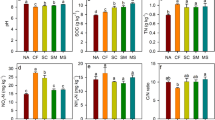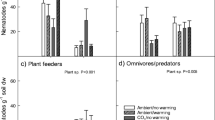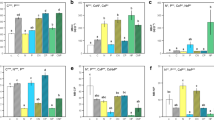Abstract
We investigated microbial responses in a late successional sedge-dominated alpine grassland to four seasons of CO2 enrichment. Part of the plots received fertilizer equivalent to 4.5g N m−2 a−1. Soil basal respiration (R mic ), the metabolic quotient for CO2 (qCO2=R mic /C mic ), microbial C and N (C mic and N mic ) as well as total soil organic C and N showed no response to CO2 enrichment alone. However, when the CO2 treatment was combined with fertilizer addition R mic and qCO2 were statistically significantly higher under elevated CO2 than under ambient conditions (+57% and +71%, respectively). Fertilizer addition increased microbial N pools by 17%, but this was not influenced by elevated CO2. Microbial C was neither affected by elevated CO2 nor fertilizer. The lack of a CO2-effect in unfertilized plots was suprising in the light of our evidence (based on C balance) that enhanced soil C inputs must have occurred under elevated CO2 regardless of fertilizer treatment. Based on these data and other published work we suggest that microbial responses to elevated CO2 in such stable, late-successional ecosystems are limited by the availability of mineral nutrients and that results obtained with fertile or heavily disturbed substrates are unsuitable to predict future microbial responses to elevated CO2 in natural systems. However, when nutrient limitation is removed (e.g. by wet nitrogen deposition) microbes make use of the additional carbon introduced into the soil system. We believe that the response of natural ecosystems to elevated CO2 must be studied in situ in natural, undisturbed systems.
Similar content being viewed by others
References
Anderson J P E and Dornsch K H 1978 A physiological method for The quantitative measurement of microbial biomass in soils. Soil Biol. Biochem. 10, 215–221.
Brookes P C, Landman A, Pruden G and Jenkinson D S 1985 Chloroform fumigation and the release of soil nitrogen: A rapid direct extraction method to measure microbial biomass nitrogen in soil. Soil Biol. Biochem. 176, 837–842.
Cabrera M L and Beare M H 1993 Alkaline persulphate oxidation for determining total nitrogen in microbial biomass extracts. Soil Sci. Soc. Am. J. 57, 1007–1012.
Cheng W and Coleman D C 1989 A simple method for measuring CO2 in a continuous airflow system: modifications to the substrate-induced respiration technique. Soil Biol. Biochem. 21, 385–388.
Cheng W and Virginia R A G 1993 Measurement of microbial biomass in arctic tundra soils using fumigation-extraction and substrate-induced respiration procedures. Soil Biol. Biochem. 251, 135–141.
Curtis P S, O'Neill E G, Teeri J A, Zak D R and Pregitzer K S 1994 Belowground responses to rising atmospheric CO2: Implications for plants, soil biota and ecosystem processes. Plant and Soil 165, 1–6.
Díaz S, Grime J P, Harris J and McPherson E 1993 Evidence of a feedback mechanism limiting plant response to elevated carbon dioxide. Nature 364, 616–617.
Diemer M W 1994 Mid-season gas exchange of an alpine grassland under elevated CO2. Oecologia 98, 429–435.
Gammon R H E, Sundquist E and Fraser P J 1985 History of carbon dioxide in the atmosphere. In Atmospheric Carbon Dioxide and the Global Carbon Cycle. Ed. RTrabalka. pp 25–62. DOE/ER-0239, US Department of Energy, Washington, DC.
Gorissen T 1994 Microbial activity and soil carbon dynamics in a changing climate. Change 21, 6–8.
Gosz J R and Fisher F M 1984 Microbial responses to ecosystem perturbations: Influence of clear-cutting on selected microbial processes in forest soils. In Current Perspectives in Microbial Ecology, Proceedings of the Third International Symposium on Microbial Ecology. Eds. M JKlug and C AReddy. pp 523–530. American Society for Microbiology, Washington, DC.
Hartwig U A, Zanetti S, Hebeisen T, Lüscher A, Frehner M, Fischer B, vanKessel C, Hendrey G R, Blum H and Nösberger J 1996 Symbiotic nitrogen fixation: one key to understand the response of temperate grassland-ecosystems to elevated CO2? In Carbon Dioxide, Populations, and Communities. Eds. ChKörner and FBazzaz. pp 253–264. Academic Press, New York, USA.
Körner Ch, Diemer M, Schäppi B and Zimmermann L 1995 The response of alpine vegetation to elevated CO2. In Terrestrial Ecosystem Response to Elevated CO2. Eds. G WKoch and H AMooney. pp 177–196. Physiological ecology series, Academic Press, New York.
Körner Ch 1995 Biodiversity and CO2: Global change is under way. GAIA 4, 234–243.
Körner Ch, Bazaz F A and Field C B 1996 The significance of biological variation, organism interactions, and life histories in CO2 research. In Carbon Dioxide, Populations, and Communities. Eds. CKörner and F ABazzaz. pp 443–456. Physiological ecology series, Academic Press, New York.
Koroleff F 1983 Determination of nutrients. In Methods of Seawater Analysis, 2nd edition. Eds. KGrasshoff, MErhardt and KKremling. pp 162–169, Verlag Chemie, Weinheim, Germany.
Leadley P W and Körner Ch 1996 Effects of elevated CO2 on plant species dominance in a highly diverse calcareous grassland. In Carbon Dioxide, Populations, and Communities. Eds. ChKörner and FBazzaz. pp 159–179. Academic Press, New York, USA
Liljeroth E, vanVeen J A and Miller H J 1990 Assimilate translocation to the rhizosphere of two wheat cultivars and subsequent utilisation by microorganisms at two soil nitrogen levels. Soil Biol. Biochem. 228, 1015–1021.
Meharg A A 1994 A critical review of labelling techniques used to quantify rhizosphere carbon-flow. Plant and Soil 166, 55–62.
Merckx R, Dijkstra A, denHartog A and vanVeen J A 1987 Production of root-derived material and associated microbial growth in soil at different nutrient levels. Biol. Fertil. Soils 5, 126–132.
Mueller T, Joergenson R G and Meyer B 1992 Estimation of soil microbial biomass C in the presence of living roots by fumigation-extraction. Soil Biol. Biochem. 242, 179–181.
Norby R J 1994 Issues and perspectives for investigating root responses to elevated atmospheric carbon dioxide. Plant and Soil 165, 9–20.
Payne R W, Lane P W, Digby P G N, Harding S A, Leech P K, Morgan G W, Todd A D, Tompson R, Tunnicliffe Wilson G, Welham S J and White R P 1993 Genstat V Reference Manual. Clarendon Press, Oxford.
Parton W J, Scurlock J M O, Ojima D S, Schimel D S and Hall D O 1995 Impact of climate change on grassland production and soil carbon worldwide. Global Change Biol. 1, 13–22.
Paul E A and Voroney R P 1984 Field interpretation of microbial biomass activity measurements. In Current Perspectives in Microbial Ecology, Proceedings of the Third International Symposium on Microbial Ecology. Eds. M JKlug and C AReddy. pp 509–514. American Society for Microbiology, Washington, DC.
Rice C W, Garcia F O, Hampton C O and Owensby C E 1994 Soil microbial response in tallgrass prairie to elevated CO2. Plant and Soil 165, 67–74.
Schanz F, Keller M and Niederhauser P 1994 Einfluss von Umweltfaktoren auf den Diatomeen-Aufwuchs von Hochgebirgsseen der Zentralalpen (Gotthardgebiet). Verhandl. Gesellsch. Ökol. 23, 57–62.
SAS Institute 1993 SAS/STAT user's guide, version 6, 4th ed. SAS Institute, Cary, NC.
Schäppi B and Körner Ch 1996 Growth response of an alpine grassland to elevated CO2. Oecologia 105, 43–52.
Scheiner S M 1993 Introduction: theories, hypotheses, and statistics. In Design and Analysis of Ecological Experiments. Eds. S MScheiner and JGurevitch. pp 1–13. Chapman and Hall, New York.
Schimel D S 1995 Terrestrial ecosystems and the carbon cycle. Global Change Biol. 1 77–91.
Smith J L and Paul E A 1990 The significance of soil microbial biomass estimations. In Soil Biochemistry. Eds. JBollag, GStotzky. pp 357–393, Marcel Dekker, NY, USA.
Sparling G P and West A W 1989 Importance of soil water content when estimating microbial biomass C, N and P by the fumigation-extraction method. Soil Biol. Biochem. 21, 245–253.
Sparling G P, West A W and Whale K N 1985 Interference from plant roots in the estimation of soil microbial ATP, C, N and P Soil Biol. Biochem. 173, 275–278.
Sparling G P, Feltham C W, Reynolds J, West A W and Singleton P 1990 Estimation of soil microbial C by a fumigation-extraction method: use on soils of high organic matter content, and a reassessment of the k EC factor. Soil Biol. Biochem. 223, 301–307.
Steinger T, Körner C and Schmid B (1996) Long-term persistence in a changing climate: DNA analysis suggests very old ages of clones of alpine Carex curvula. Oecologia 105, 94–99.
Swinnen J, vanVeen J A and Merckx R 1994 14C pulse-labelling of field-grown spring wheat: An evaluation of its use in rhizosphere carbon budget estimations. Soil Biol. Biochem. 262, 161–170.
Vance E D, Brookes P C and Jenkinson D S 1987 An extraction method for measuring soil microbial biomass. Soil Biol. Biochem. 196, 703–707.
Van deGeijn S C and vanVeen J A 1993 Implications of increased carbon dioxide levels for carbon input and turnover in soils. Vegetatio 104/105, 283–292.
VanVeen J A, Liljeroth E and Lekkerkerk L J A 1991 Carbon fluxes in plant-soil systems at elevated atmospheric CO2 levels. Ecol. Appl. 12, 175–181.
Zak D R, Pregitzer K S, Curtis P S, Teeri J A, Fogel R and Randlett D L, 1993 Elevated atmospheric CO2 and feedback between carbon and nitrogen cycles. Plant and Soil 151, 105–117.
Zar J H 1984 Biostatistical analysis. Prentice Hall, Englewood Cliffs, New Jersey. 718 p.
Author information
Authors and Affiliations
Rights and permissions
About this article
Cite this article
Niklaus, P.A., Körner, C. Responses of soil microbiota of a late successional alpine grassland to long term CO2 enrichment. Plant Soil 184, 219–229 (1996). https://doi.org/10.1007/BF00010451
Received:
Accepted:
Issue Date:
DOI: https://doi.org/10.1007/BF00010451




